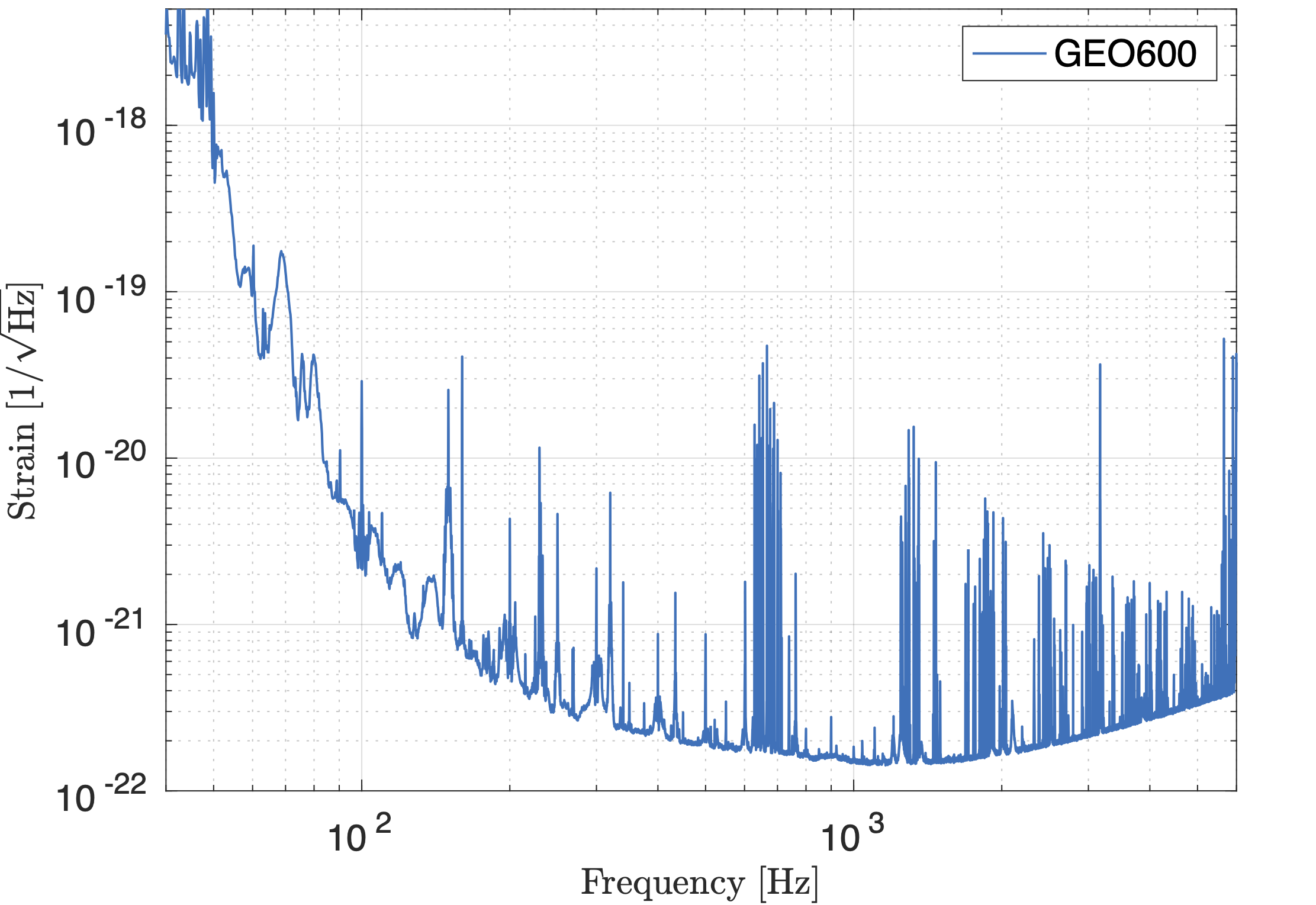O3GK Instrumental Lines for GEO 600
The plot below shows the amplitude spectral density (ASD) of the total strain noise in GEO 600 (blue line) detector (reproduced from the O3GK paper). The curve is the mean sensitivity during O3GK. The plot shows frequency [Hz] on the x-axis, and the ASD value [ 1 / sqrt(Hz) ] on the y-axis.
The spectra reveal a large number of "lines" due to instrumental artifacts:

The most prominent peaks
The peaks that are most noticeable to the eye are all believed to be due to known instrumental effects.
For GEO 600 we have:
Power line harmonics
- The main AC power on the GEO 600 site is 220V, 50 Hz. The harmonics of 50 Hz appear in almost all electronics (sensors, actuators etc.) and therefore couple to the sensitivity curve.
Violin modes
- A forest of lines appears between 600 Hz and 700 Hz. These are the violin modes of the triple suspensions as well as that of the beam splitter. In some instances, a frequency doublet is visible.
Dither lines for control
- Beam Directing Optics (BDOs) steer the beam from interfefometric darkport (through the signal recycling mirror) into the output mode cleaner. Dither lines for "beacon-dither" alignment control at 17 Hz and 11 Hz (plus first harmonics at 34 Hz & 22 Hz) are respectively from dithering in Rot (Yaw) and Tilt (Pitch) DOF of BDO1 mirror. Similarly lines at 3.5 Hz and 14 Hz arise from dithering BDO3 mirror.
- The beacon for the “beacon-dither” at 3170 Hz is applied differentially via the electrostatic drive (ESD) to the end mirrors (MCN and MCE) of the Michelson interferometer. This marks the alignment of the optical mode of a GW signal.
- At 6000 Hz is the dither line applied to the OMC length for control via the dither technique.
ESD calibration lines for DARM displacement
- Lines at 434 Hz, 762 Hz and 2136 Hz are injected via the electrostatic drive actuator for the diffential arm length calibration.
Photon calibrator lines
- The photon pressure calibration (Pcal) line at 160 Hz uses the radiation pressure from an amplitude modulated laser to calibrate the displacement sensitivity of the detector. The second harmonic at 320 Hz is also prominently visible.
- The beat between the Pcal line and the 3.5 dither (BDO3 rotation alignment) appears at 316.5 Hz and 323.5 Hz.
References
- Grote, Hartmut: Making it work : second generation interferometry in GEO 600!. Hannover : Universität, Diss., 2003, 202 S.
- Hild, Stefan: Beyond the first generation : extending the science range of the gravitational wave detector GEO 600. Hannover : Gottfried Wilhelm Leibniz Universität, Diss., 2007, 219 S.
- Goßler, Stefan: The suspension systems of the interferometric gravitational-wave detector GEO 600. Hannover : Universität, Diss., 2004, 233 S.
Instrumental line catalog
The following files contain lists of prominent spectral line frequencies. Each entry contains the line frequency, artifact type, and comments for each type of artifact. The intent is to identify spectral lines that we are confident are of instrumental (not astrophysical) origin, even if we don't understand the mechanism by which they show up in the strain data; they therefore are safe to ignore or "clean" (remove in an analysis-dependent way) when searching for CW signals.
- Text file line catalogs:
It is likely that you will need to speak with a GEO 600 expert to understand the details of what you find in this catalog. You can start by checking our contact page.
